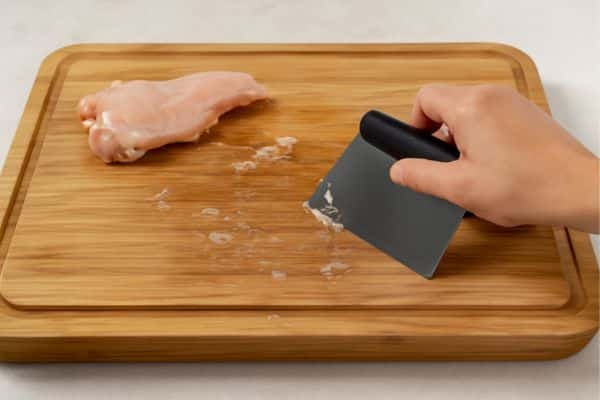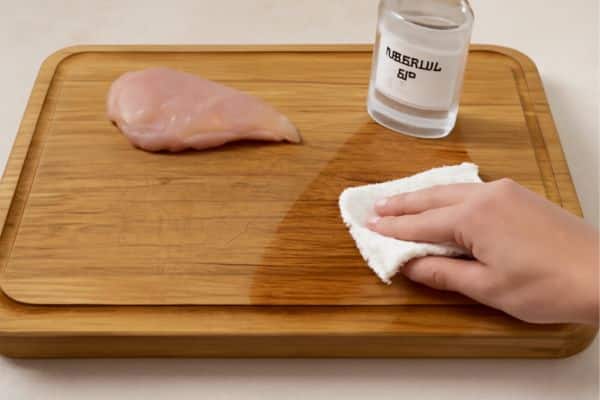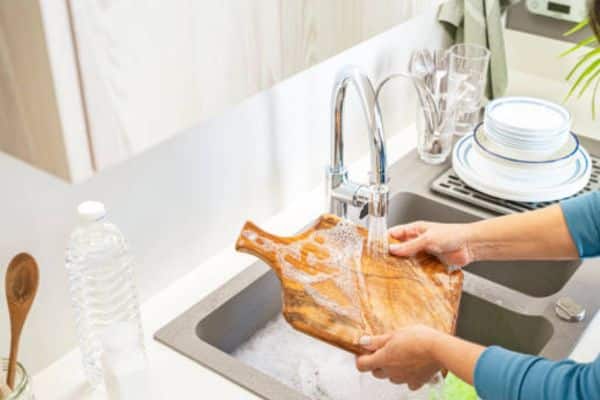Cleaning a cutting board after chicken is key to a safe kitchen. I learned this the hard way. One time, I cut raw chicken and didn’t clean the board properly. The next day, someone in my family got sick. That’s when I realised how important it is to clean the cutting board well. Now, I always sanitise the board after handling raw chicken. Bacteria like salmonella and Campylobacter are common in raw chicken. These germs can spread easily if not cleaned properly. A clean board prevents cross-contamination and keeps your kitchen safe. It’s simple to clean your cutting board. Taking a few extra steps makes a big difference. Let’s look at how to clean a cutting board after chicken. This will help keep your kitchen fresh and healthy.
Why Cleaning a Cutting Board After Chicken Is Crucial
I used to think washing my cutting board was enough after cutting raw chicken. One evening, I made dinner and didn’t clean the board properly. The next day, someone in my family got sick. That experience taught me how important it is to clean and sanitise the board after chicken. If you need a good cutting board for meats like brisket, the best cutting board for brisket is a great choice. It keeps your kitchen safe and clean.
Cross-contamination can happen quickly. Raw chicken can carry harmful bacteria like Salmonella and Campylobacter. These bacteria can spread to other foods. Wood in particular, can trap juices and bacteria in tiny cracks. Without proper cleaning, the germs stick around and can cause illness.
Proper cleaning and sanitising are the best way to prevent this. It’s not just about washing the board with water. You need to sanitise it with the right solution to kill any harmful bacteria.
01. Scrape Off Residual Chicken

First, scrape off any leftover chicken meat and juices. This will help remove visible bits and prevent them from building up. It also helps reduce the risk of bacteria sticking to the surface.
02. Wash the Board With Hot, Soapy Water
Next, Wash the with hot water and dish soap. Hot water helps break down grease, while the soap removes any leftover juices or oils. Scrub the thoroughly, paying extra attention to the edges and grooves where food might get stuck.
03. Sanitize the Cutting Board

After washing, it’s time to sanitise. You can use a simple vinegar solution or a bleach mixture to kill harmful bacteria. A common method is mixing 1 tablespoon of bleach with 1 gallon of water. Apply this solution to the and let it sit for a few minutes.
04. Dry Properly

Once the board is sanitized, dry it with a clean towel or let it air dry. Make sure the board is completely dry to prevent moisture buildup, which can lead to bacterial growth.
05. Store and Maintain the Board
Finally, store the board properly. Keep it upright in a well-ventilated area. This helps it dry thoroughly and prevents bacteria from growing. Regularly oil wooden boards to maintain their condition and prevent cracks where bacteria can hide.
How to Sanitize a Wooden Cutting Board After Chicken

Wood-Specific Care
They are trickier to sanitize than plastic or glass boards. The wood’s natural grains can trap juices and bacteria, making it harder to clean. This is especially true after cutting raw chicken. The small cracks in the wood can hold onto germs, which is why extra care is needed.
Best Practices for Wooden Boards
Use a food-safe sanitiser. A simple vinegar solution works well—mix equal parts vinegar and water. You can also use a bleach solution (1 tablespoon of bleach per gallon of water). Let it sit for a few minutes, then wipe it down.
Regular Maintenance
To keep your wooden board in good condition, treat it with food-safe mineral oil. This will seal the wood and prevent cracks, which can trap bacteria. Oiling it regularly keeps the safe and lasts longer.
Avoid Soaking in Water
Never soak your wooden in water. Wood is porous, and soaking can cause it to warp or crack. Instead, clean the board quickly, dry it well, and oil it to maintain its strength.
How to Clean a Cutting Board – Different Types, Different Methods

Plastic vs. Wood Cutting Boards
Plastic and wood need different care. They are easy to clean. You can wash them with hot water, soap, or even put them in the dishwasher. However, plastic can scratch easily, which may trap germs. Wood require more care. They can absorb juices and bacteria, so sanitize them with vinegar or bleach solutions and oil them regularly.
Use plastic boards for raw meat. They are easier to clean and sanitize. Wood boards are better for cutting vegetables and bread. However, after using a wooden for meat, make sure to clean it well to prevent bacteria from spreading.
Glass and Bamboo Cutting Boards
Glass boards are simple to clean. They don’t absorb bacteria, but they can be tough on knives and might crack if dropped. Wash them with soapy water and dry them well. Bamboo boards are eco-friendly, but they can scratch. Clean them with mild soap and water, then dry them right away. Like wood, bamboo boards should be oiled to prevent cracks.
Pro Tips for Keeping Your Cutting Board Clean and Safe
Routine Maintenance
For wooden boards, oil them with food-safe mineral oil. This prevents cracks and keeps germs out. For plastic, replace them once they get too scratched. You can also use a separate board for raw meat to avoid germs spreading.
Preventing Stains and Odours
Use baking soda for stains and odours. Sprinkle it on, let it sit, then scrub it away. It helps remove tough marks and leaves the clean. You can also rub lemon juice on the surface to freshen it up naturally.
Storage Tips
Store your board upright in a dry, well-ventilated area. This allows it to dry completely and prevents bacterial growth. For wood, avoid wet areas like sinks to prevent warping. Proper storage keeps your board safe and extends its life.
Final Thoughts
Cleaning your cutting board after raw chicken should be a regular habit. It’s a simple step that prevents harmful bacteria from spreading. A clean kitchen helps keep your food safe and protects your family from illness. Taking a few minutes to clean properly will give you peace of mind, knowing you are keeping your kitchen safe and healthy.


